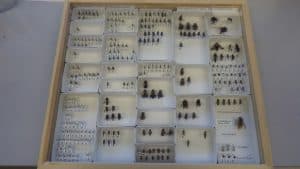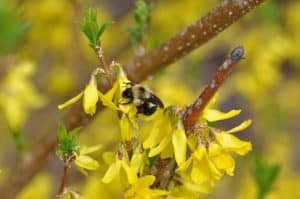Share this article
Surveying native bee species
There are close to 4,000 species of bees in North America. Bees are distinct from wasps and flies in that they are insects that collect pollen and nectar to feed to their developing young. Bees are oftentimes quite hairy, having specialized structures for collecting and transporting large quantities of pollen. Closely related are wasps, which also visit flowers for the nectar but have carnivorous young requiring animal protein (often in the form of spiders or caterpillars) for development. Most of North American bee species are solitary ground-nesters (70 percent) or twig-nesters (30 percent), where a single female builds and provisions her own nest. Very few bee species are social like honey bees (Apis mellifera) or bumble bees (~50 Bombus species), which live in colonies with a division of labor between the queen and a multitude of workers.
The natural distribution of bees varies throughout the United States based on the habitat and nutritional needs of each species. Some bees are generalists and able to collect pollen and nectar from a wide variety of plants in bloom, while other bee species are specialists and require nutrition from very specific plants or plant groups. The shrub lands in the western U.S. tend to have greater bee diversity (+1000 species) than the forests of eastern U.S. (<500 species). Diversity surveys are conducted by scientists, land agencies and hobbyists to create local and regional species lists. They use a variety of collecting techniques, such as sweep nets, traps and, in limited cases, photography. Specimens are maintained in private and public museums along with other historic bee specimens from past collecting events for researchers to use and reference.
In order to know the status of our bee species, it is important to document when and where they occur by conducting surveys or inventories. Time, funding, weather and accessibility limit the progress of documenting occurrence of native and exotic bee species. Remote areas are hard to access but provide some of the most interesting information. There are vast areas of the U.S. that do not have road access and subsequently have not been well sampled. In addition, locations need to be sampled multiple times because the composition of species can change during the season (spring bees versus fall bees) and year-to-year. Monitoring sites where long-term surveys (+10 years) are conducted provide datasets that allow researchers to look at patterns in bee populations and gain an understanding of the benefits and limitations of the data. These are based on such things as the seasonal bloom, weather variation, variation in collection methods and effort, disease and pathogens, invasive species, floral associations and land-use.

Drawer of bee specimens sorted into categories. Notice size variation between species. ©BayerBeeCare
Bee researchers, or melittologists, use active and passive collection methods during bee surveys. Using a sweep net is a form of active collection, and traps are a form of passive collection. Monitoring traps for pests (such as Japanese beetles) may inadvertently capture bees, but traps that specifically target bees are called “bee bowls” and are painted with fluorescent paints (often yellow, blue and white) to be visible to passing bees. These bowls are filled with a soapy solution that allows insects and debris to become submerged when alighting on the surface. Typically, active net collecting is coupled with traps because not all bee species are caught in the bee bowls. Likewise, not all bee species are captured by net collection methods. Once the bees are captured, they are washed, dried, fluffed, pinned, labeled, identified and entered into a database. This sequence allows researchers to verify identifications, dates and locations and augment current distribution maps.
I’m particularly passionate about surveying native bee species because of the incredible experiences it has afforded me. I have participated in several long-term surveys in remote locations of the U.S. as a collector, curator and taxonomist and in specimen processing and data entry. These opportunities have allowed me to see firsthand the magnitude of the endeavor to document our native bee fauna. Oftentimes during these surveys, new species are discovered and/or confirmed. Imagine having a life-checklist to see all the bee species in the U.S. – or around the world (+20,000 species)!
For more information on Bayer bee health initiatives, visit the Bayer Bee Care program website.
Header Image: Bee from the Andrenidae family (genus Andrena) collecting early spring dandelion pollen. ©Dick Rogers, Bayer Bee Care Center









